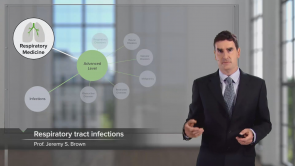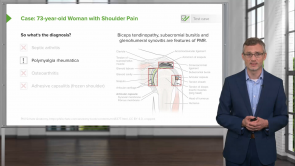Normal Abdominal and Pelvic CT Anatomy
Über den Vortrag
Der Vortrag „Normal Abdominal and Pelvic CT Anatomy“ von Hetal Verma, MD ist Bestandteil des Kurses „Year 4 – Selective Sub-Internship“. Der Vortrag ist dabei in folgende Kapitel unterteilt:
- Lung and Bone Windows
- Liver Anatomy
- Spleen, Pancreas, Gallbladder and Kidneys
- Vessels - Arterial and Venous Phase Imaging
- Bowel
Quiz zum Vortrag
What segments of the liver does the falciform ligament divide?
- The medial and lateral segments of the left lobe of the liver
- The upper and lower segments of the liver
- The caudate and quadrate lobes of the liver
- The anterior and posterior segments of the right lobe of the liver
- The caudate lobe from the rest of the liver
Why are "lung windows" used in reviewing a CT scan of the abdomen?
- To check for free intraperitoneal air in the abdomen
- To evaluate the portion of the lungs that extends into the abdomen
- To check for pulmonary emboli
- To check for lung cancer metastases to the abdominal organs
- Lung windows are only used in CT of the chest, not CT of the abdomen.
What is the width of a normal pancreatic duct?
- 3–4 mm
- 2–3 cm
- 1–2 mm
- >5 mm
- 0.5–1 mm
Which organs are retroperitoneal?
- Kidneys and ureters
- Liver and gallbladder
- Head and tail of the pancreas
- Small intestines and colon
- Spleen and uterus
Why should contrast be avoided while assessing for renal calculi?
- In the delayed phase, the contrast in the renal pelvis obscures the evaluation of a stone.
- The contrast remains much longer in the kidneys due to the stone and thus can cause damage to the kidney.
- The density of the renal stone and the portal vein during the portal venous phase is the same making it difficult to assess for the stone.
- The renal stone absorbs the contrast material to a large extent and then dissolves into smaller particles causing obstruction of the kidneys.
- In the arterial phase, the stone tends to move further into the renal medulla leading to papillary ischemia.
What is TRUE regarding imaging of the liver and spleen?
- The density of the liver and spleen are equal on CT scan imaging.
- 80% of the vascular supply to the liver is from the hepatic artery and 20% is from the portal vein.
- The liver has a bumpy contour.
- The spleen is better visualized on a CT scan than ultrasound.
- The spleen is about 6 to 10 cm in size.
A newborn child with ambiguous genitalia is suspected to have congenital adrenal hyperplasia. A CT scan of the abdomen is most likely to show abnormality in which site and organ?
- An upside-down "Y-shaped" structure on the top of the kidneys
- A "bean-shaped" structure below the spleen
- An upside-down "V-shaped" structure attached to the spleen
- A "V-shaped" structure located posterior to the inferior vena cava
- A "balloon-shaped" structure attached to the liver
Diese Kurse könnten Sie interessieren
Kundenrezensionen
5,0 von 5 Sternen
| 5 Sterne |
|
5 |
| 4 Sterne |
|
0 |
| 3 Sterne |
|
0 |
| 2 Sterne |
|
0 |
| 1 Stern |
|
0 |







